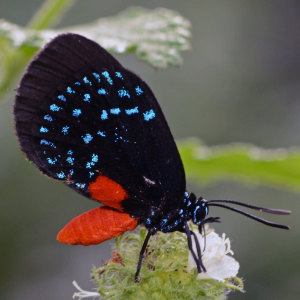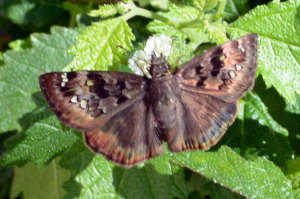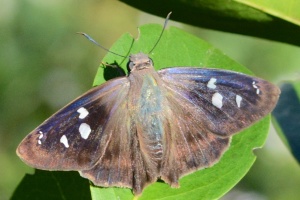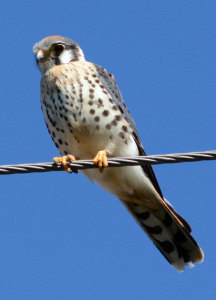November was an interesting month here. Spells of cold, wintry air alternated with spells of heat and high humidity that spoke of summer. The bugs in the yard were confused, and the winds whipped up by all the changing weather made photography tricky. Nevertheless, I did manage to get a few new species, and to welcome a few returnees. The Atala hairstreak butterfly, considered extirpated from Florida (its only U.S. home) over fifty years ago, is now a fairly routine guest near any place that contains a sufficient supply of its its host plant, coontie (Zamia punila):

These butterflies seem to show up in my yard in November; perhaps there’s some minor dispersal going on in the winter months when the coonties are at their least leafy.
Other butterflies returned this month as well, including the enigmatic Horace’s Duskywing (Erynnis horatius), whose larvae feed on the leaves of several oak species, and the adults of which are a bit camera-shy:

and the new-for-the-yard Hammock Skipper, which eats Florida fish poison tree and the exotic Pongam, the latter of which grows in the swale in front of my neighbor’s house:

I also got some decent pictures of some less lovely but still important insect fauna, like the small flower flies and chalcid wasps from last month’s inventory posts. Unfortunately, most of them disappeared due to a hard drive failure combined with my naive faith in a networked Time Machine backup with illegal Unix characters in the file name. I still have the backup, theoretically, and when I can afford to drop a few large on a data mafioso, perhaps I’ll be able to recover them. Until then, I can just thank my lucky stars that I’d started this draft post and uploaded a few pix before the crash…
Dragonfly numbers declined precipitously after the beginning of the month despite the few spells of rain and heat; apparently the young males of Band-winged Dragonlet aren’t abundant year-round. Despite that, Pantala flavescens, the wandering glider, returned to the yard, which was nice, although the photos are missing. Green Darners visited on a few occasions, but overall there were very few odonates after the first of the month.
A pipsqueaky (and very squeaky!) American Kestrel sat on the wire on a couple of different occasions:

A Cooper’s Hawk did also, but was too flighty for me to grab a picture of.
And that’s about all I can remember of my nature sightings for the month. I’m going to have to start using paper and pen, the old-fashioned way!
